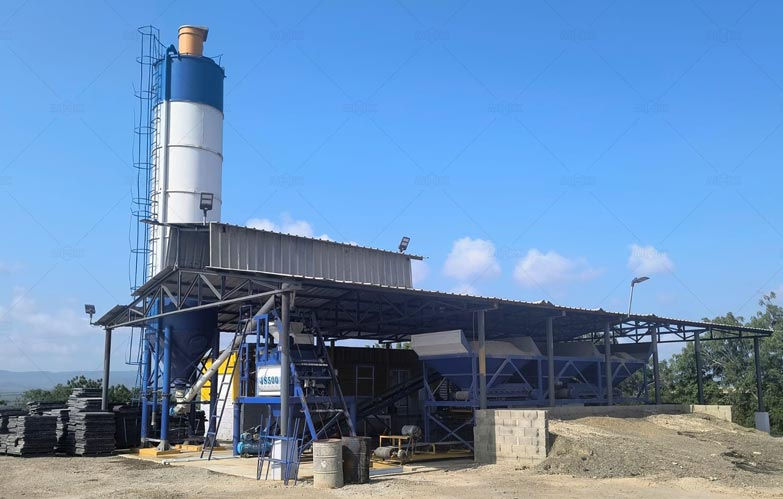How Combining Remote Control With On-Site Operation Improves Batching Plant Management Flexibility
- Aimix maquina

- 10 ago
- 4 Min. de lectura
In the fast-paced construction industry, efficiency and adaptability are critical for success. For concrete batching plant operators in diverse markets such as Latin America, managing production across varied project sizes and locations can be challenging. One effective solution is combining remote control capabilities with traditional on-site operation. This dual approach allows operators to oversee production from virtually anywhere while still maintaining the option for direct, hands-on control at the plant. By integrating both methods, producers can maximize productivity, enhance responsiveness, and ensure quality, whether working with a large stationary facility, a mobile concrete plant, or a mini concrete plant in a remote area.
Understanding The Combination Of Remote And On-Site Control
In a modern concrete plant(planta de hormigon), remote control refers to the use of digital platforms, IoT technologies, and mobile devices to monitor and manage production from off-site locations. This can include adjusting batching parameters, tracking inventory levels, and receiving alerts about maintenance needs. On-site operation, on the other hand, involves physically operating control panels or touchscreen systems at the plant itself.
When these two methods are combined, plant management gains a new level of flexibility. Remote control allows for oversight and adjustments during travel or when managing multiple sites, while on-site operation ensures immediate, manual intervention when precise control or troubleshooting is required.

Enhanced Operational Flexibility Across Project Types
Combining remote and on-site control makes it easier to adapt to the wide variety of construction projects common in Latin America. Large-scale infrastructure projects benefit from remote oversight that allows managers to coordinate multiple plants simultaneously, while smaller, localized builds—often supported by a mini concrete plant—still require on-site presence for hands-on quality assurance.
For example, a project in an urban center might use a mobile concrete plant(planta de concreto movil) for quick deployment and manage it remotely to adjust production based on real-time demand. Meanwhile, operators on-site ensure that the concrete meets the specific requirements for each delivery.
Faster Decision-Making And Reduced Downtime
In construction, delays can lead to significant financial losses. Remote control enables supervisors to receive instant alerts about potential issues such as material shortages, equipment malfunctions, or deviations in mix quality. They can make quick adjustments from a distance, preventing minor problems from becoming major disruptions.
On-site operation complements this by allowing immediate manual intervention if a technical issue cannot be resolved remotely. This dual capability reduces downtime, keeps production schedules on track, and supports timely project completion—a competitive advantage for any concrete plant operator.
Improved Quality Control And Consistency
Quality control is crucial for maintaining client trust and meeting regulatory requirements. Remote control systems can monitor parameters like water-to-cement ratio, mixing time, and aggregate size in real time. These adjustments can be made instantly from any location, ensuring consistency across batches.
However, certain quality checks still require physical inspection—something only on-site operators can perform effectively. This combination ensures that every batch meets specifications, whether it is produced at a central concrete plant or a temporary mobile concrete plant set up on a construction site.
Efficient Resource And Workforce Management
By enabling remote control, managers can optimize resource allocation without being physically present at every plant. They can monitor multiple sites, adjust production levels according to demand, and even schedule maintenance without disrupting operations. This is particularly useful for companies operating several mini concrete plant(planta de concreto pequeña) units in different regions.
On-site staff, meanwhile, can focus on executing the production process, handling equipment, and responding to immediate needs. This division of responsibilities ensures smoother workflows and better use of skilled labor.
Cost Savings And Better Return On Investment
While adding remote control capabilities to a concrete plant requires an initial investment in technology, the long-term benefits include reduced travel costs, minimized downtime, and lower risk of production delays. The ability to manage multiple plants remotely allows companies to expand their operational footprint without significantly increasing overhead.
For mobile concrete plant and mini concrete plant operations, this flexibility is especially valuable. Remote monitoring ensures that even plants in remote or difficult-to-reach locations maintain high performance without constant on-site supervision from senior managers.
Meeting The Demands Of The Latin American Market
The Latin American construction sector is characterized by diverse geography, varying infrastructure quality, and fluctuating demand. A combination of remote and on-site operation addresses these challenges by offering scalability and adaptability. Remote control ensures managers can oversee operations across vast distances, while on-site operation guarantees that production quality is maintained despite local variables such as weather or material supply conditions.
This hybrid approach is ideal for companies looking to serve both large metropolitan projects and smaller rural developments without compromising on efficiency or quality.

Conclusion
Combining remote control with on-site operation is transforming the way batching plants are managed in Latin America. This dual approach offers unparalleled flexibility, enabling operators to respond quickly to challenges, maintain consistent quality, and optimize resources across diverse projects. Whether running a large central concrete plant, a mobile concrete plant for temporary sites, or a mini concrete plant in a remote location, adopting this strategy can lead to improved efficiency, reduced costs, and a stronger competitive position in the market. For forward-thinking producers, integrating both control methods is no longer optional—it is an essential part of staying ahead in the construction industry.



Comentarios